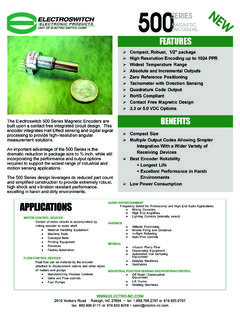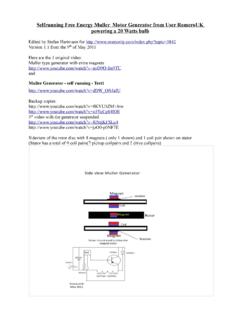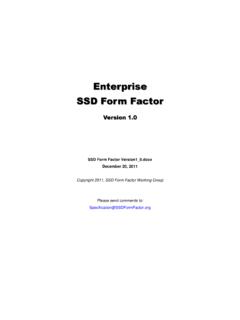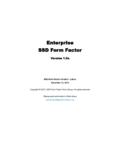Transcription of Tony Ryan
1 By:Tony RyanSpecial Needs (Gifted &Talented) ConsultantSouth Coast Education RegionQueenslandLIMITED REPRODUCTION PERMISSIONP ermission is granted to schools or parents who purchase this book to reproduceany part of this material for classroom or personal duplication is prohibited. 1990 Table of ContentsPageThe Origins ..2 The Need for Creative Thinking ..2 The Age of Artificial Intelligence ..3 Acknowledgements ..3 General References ..4 THE THINKER'S keys :The Reverse ..5 The What If .. (an example of What If sheet - Ideas Wheel) .. (reproducible What If sheet- Ideas Wheel) ..7 The Disadvantages ..8 The Combination ..8 The BAR ..9 The Alphabet ..10 The Variations ..10 The Picture ..11 The Prediction ..11 The Different Uses ..12 The Ridiculous ..12 The Commonality ..13 The Question ..13 The Brainstorming ..14 The Inventions ..14 The Brick Wall ..15 The Construction ..15 The Forced Relationships ..16 The Alternative ..16 The Interpretation ..17 THE THEMES:The Environment.
2 Space ..22 Under the Sea ..24 Transport ..26 Food ..28 Dinosaurs ..30 Christmas ..32 Communications/Media ..34 Sport ..36 Animals ..38 The Future ..40 DESIGN YOUR OWN ACTIVITIES ..42 1 THE ORIGINSWhen I initially designed the Thinker s keys in the following pages, the impetusfor my ideas came directly from two marvellous books on the teaching of thinking. Thefirst of these was The Thinker s Toolbox (Thornburg and Thornburg, 1989) in which 16different teaching strategies, known as Thinker s Tools, were outlined for classroomuse. It is these Thinker s Tools that led directly to the concept of the Thinker s second stimulus for my thinking came from the brilliant Adventures inThinking (Joan Dalton, 1986). Among the many excellent features of this book was asection known as The Festival of Practical Ideas , in which the author presented a hugerange of innovative activities arranged in a thematic me, it appeared quite obvious that the new Thinker s keys should be linkedwith the thematic approach to teaching, as outlined in Adventures in Thinking.
3 As aresult, this booklet has been presented in two integrative sections. In Part A, a briefdescription has been provided for each of the twenty Thinker s keys , while in Part B, atotal of twelve themes have been chosen to demonstrate the type of ideas that can begenerated with the , there is nothing new about the teaching of thinking or about thethematic approach. Thousands of teachers throughout the world have been applyingthese philosophies for many years. The distinguishing feature of this booklet, however,is that it forms a link between the thinking strategies and the themes in a simplisticand effective NEED FOR CREATIVE THINKINGThe majority of the keys place emphasis upon the development of innovative andcreative thinking. I have done this for three important reasons:1. Creative thinking can be exciting and enjoyable. This active participation can thencreate a positive attitude towards the learning The stimulation of creativity in learning heightens the emotional link with thatlearning.
4 This emotional involvement boosts the effectiveness of our Developing our creative potential will strengthen our ability to cope with there is one thing that we can guarantee into the 21st century, it will be theexponential rate of change that will affect the world. When our thinking is open-ended and accepting of new ideas, we become much more capable of adapting tothese changing circumstances. 2 THE AGE OF ARTIFICIAL INTELLIGENCEC reative thinking assumes even greater importance when we consider thepotential of artificial intelligence. The world is now well into the Information Age, andcomputers continue to rapidly overtake many of the analytical thinking functions thatwe formerly entrusted to our is obvious that computers will eventually be able to fulfil most of thesefunctions. Thus, the occupations waiting for today s students in the 21st century will bethose that computers are not capable of doing. These future occupations are likely toinvolve a strong creative and personal does this leave today s students?
5 There is no point in radically altering thepresent curriculum, because rapid change has never worked anywhere, particularly inthe education system. Keeping this point in mind, however, it is important that weintegrate creative activities into our present structures, and provide children withstrong coping mechanisms for their uncertain would like to acknowledge the following people for their marvellouscontribution to the development of my own thinking in the past six years: ,The many teachers in the South Coast Education region for welcoming me intotheir classrooms, and encouraging me to develop the concepts and ideas in thisbooklet before they were printed; ,The South Coast Education region consultancy team, who constantly strive for thehighest professional standards in such a positive manner; ,The state-wide team of consultants for Gifted and Talented Education for theirwonderful support and encouragement; and ,Joan Dalton and Julie Boyd (Teamlinks Australia), who are simply Ryan (October, 1991) 3 GENERAL REFERENCESC arnow, and Gibson, Thinkers Guide,Dale Seymour Publications, USA, , in Thinking,Thomas Nelson, Australia, 1985de Bono, : Beyond Yes and No,Penguin, , Workshop,Hawker Brownlow Education, Aust, , J.
6 And Aburdene, the Corporation,Warner Books, , P. and Thornburg, Thinker's Toolbox,Dale Seymour Publications, USA, Oech, Whack On The Side Of The Head : HowTo Unlock Your Mind For Innovation,Angus and Robertson, USA, special thanks to Cheryll Beaumont, whose superb secretarial abilitieswere admirably demonstrated in the compilation of this booklet. 4 THE EXPLANATION OF THE THINKER S KEYS1. The REVERSE Place words such as cannot, never and not in sentences which are commonlydisplayed in a listing JUSTIFICATION:Students are too often required to regurgitate endless lists of facts. Moving in theopposite direction still requires a sound knowledge base, but it forces students to EXAMPLE:Name 10 things that you could not 5 sounds that you have never 10 things that you could not The WHAT IF You can ask virtually any What If question. They can be either serious or frivolous. Oneexcellent means of displaying ideas from this key is to draw up an Ideas JUSTIFICATION:Great for introducing an area of study, and for tapping into the students knowledgebase.
7 It also generates loads of innovative EXAMPLE:1. What if the price of petrol was immediately doubled?2. What if all cars turned into skateboards?Now construct an Ideas Wheel. Place the base statement in the middle circle, and put 5consequences of that event in the 5 outer deal with each of the 5 outer circles in turn. Put 3 consequences of each of theseinto the smaller circles. (see Figures i and ii) 5 Figure . iLesspollutionAll carsturned intoskateboardsDriving agereduced from17 to 5 Everyone would befitterHigherinjuryrateCar parkswould bemuch smallerconstant updating of licence photoshuge rise in traffic infringementsmore licence testing centrespeople wouldlive longerobsolete fitness centresless usageof medicationcrutchcompaniesprofitablemoreB loodBanksovercrowdedhospitalshappierasth maticslessconservationistsprettiersunris eseasier tofind yourskateboardless walkingwhen shoppingmore roomfor skateboardramps 6 Figure . iiFor use in classrooms 7 3. The DISADVANTAGES Choose an object, eg an umbrella, or a practice, eg playground duty, and list a number ofits disadvantages.
8 Then list some ways of correcting, or eliminating these JUSTIFICATION:We often accept the inadequacies of many products, without really considering how theycan be improved. Practise this key and you will be amazed at the number of everydayproducts which can be further EXAMPLE:An Umbrella: The DisadvantagesThe ImprovementsThe sharp sections can poke you in the flat erasers onto the end ofeach take up too much room,Develop a series of locking hingeseven when the length of the drips onto your an overhanging plastic sheetto the edges of the The COMBINATION List the attributes of 2 dissimilar objects (one within your area of study, one outside),then combine the attributes into a single JUSTIFICATION:Many important inventions, such as the disposable razor (the concept of loading bulletsinto a rifle, combined with a normal razor) and the first printing press (the wine pressand the coin punch) were created in this EXAMPLE:A leaf and a LeafThe MousetrapThey change colours through the are made of wood and often eat can kill are millions of can be left in lots of places.
9 8 THE COMBINATIONS:1. A miniature mousetrap for placing on leaves, that can kill insects when they try to eatthe Mousetraps that can change colour and blend in with the surface on which they The B A R The following acronym, or ladder of words, can be used by different age groups (rangingfrom Yr 1 to adults) to reinvent or redesign everyday JUSTIFICATION:A practical step-by-step strategy for developing innovative and highly unusual type of strategy is often used in today s hightech product development laboratoriesto create new products for the Ladder is:BiggerAddReplaceTHE EXAMPLE:B A R a skateboard. Ask the students todraw a standard skateboard, and thendirect them through the steps one at a 's one series of possibilities:B iggerExtend the rear of the skateboard, making it much bigger, and put someshelves on it for storage space. Place a counterweight on the front to balanceit a small rocket motor, which can be controlled with a foot throttle nearthe back of the the wheels with a small hovercraft unit, which is controlled by ahand-held rotating is very important that SILLY and INNOVATIVE ideas are encouraged.
10 Very few newideas emerge from predictable and tedious efforts. 9 6. The ALPHABET Choose an object or general category of objects which features in the area of study andcompile a list of words from A to Z which have some relevance to the object/s. Then tryto expand on some ideas which link with each of the JUSTIFICATION:Using the alphabetical format clarifies students thinking. It is a sorting process which ismade easier by considering one aspect at a EXAMPLE:Sport (specifically tennis)A. Antbed courts - does this mean that ants can play tennis while in bed?; perhaps aminiature game of tennis could be devised as a board game, with each of the playersbeing activated by remote Bouncing - could tennis racquets be constructed of a special rubber so that they couldbounce as well?; this feature could be included in a new version of tennis. Perhapsthe rules would require each player to bounce the racquet after every shot is continue with C through to Z. If the students draw a blank with a particular letter,simply move on, and return to that letter at a later a more simplified version, merely list single objects from A to Z, Foods:A - artichokeB - beetroot The VARIATIONS This key employs a special group of words.






